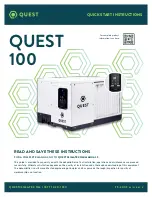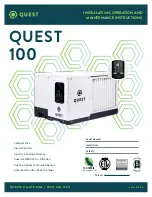
35
EGW05-SWHPEG-20140724
TM
TM
AUXILIARY AIR HEATING SYSTEM (11)
The auxiliary heating system is normally factory-installed inside the PoolPak™ unit. In this case, all interface wiring
between the ECC III and the heater is factory-installed. If the PoolPak is not equipped with an auxiliary heating option,
the ECC III provides contact closures to control three discrete stages of auxiliary air heating. The contacts may be directly
connected to the heater’s control circuit, provided it is 24 VAC maximum and the current does not exceed 1A inductive.
The three outputs are energized in order, by number, as heating demands dictate.
SYSTEM 1 REMOTE AIR-COOLED CONDENSER INTERLOCK AND CONTROL (12)
The ECC III monitors terminals T10.1 and T10.2 for 120 VAC from the remote air-cooled condenser. This 120 VAC proof
signal indicates that power is on at the remote condenser. The ECC III will not select the mechanical air conditioning
mode if the proof signal is inactive. When mechanical air conditioning is selected, a 120 VAC control signal is sent to the
remote condenser through terminals T10.3 and T10.4. This signal energizes the fan starters in the ACC.
SYSTEM 2 REMOTE AIR-COOLED CONDENSER INTERLOCK AND CONTROL (13)
The ECC III monitors terminals T11.1 and T11.2 for 120 VAC provided by the remote air-cooled condenser. This 120
VAC proof signal indicates that power is on at the remote condenser. In most cases, a single remote condenser is used
for both system 1 and system 2. For this reason, the factory installs jumpers from T10.1 and T10.2 to T11.1 and T11.2,
respectively. This allows a single 120 VAC proof signal from the condenser to activate the proof input of both systems.
When mechanical air conditioning is selected, a 120 VAC control signal is sent to the remote condenser through
terminals T11.3 and T11.4. This signal energizes the fan starters in the ACC.
AUXILIARY AIR HEAT CONTROL VALVE (14)
The ECC III provides an analog signal to control a proportional hot water or steam valve. Normally, the valve is factory-
mounted and wired inside the PoolPak™ unit. However, if a remote valve is used, it can be connected directly to the
PoolPak™ control panel. Terminal block T12 provides 24 VDC power and a control signal. The actuator on the external
valve must consume less than 5 VA at 24 VDC. The default control signal to the actuator is 2-10 VDC. The voltage span of
the control signal can be adjusted in the configuration menu.
BUILDING AUTOMATION SYSTEM CONNECTION (15)
The ECC III is capable of direct connection to BACnet IP or MS/TP, LonWorks, or Modbus RTU BAS systems. When
equipped with the LonWorks interface, the ECC III utilizes an Echelon FTT10 transceiver for connection to a TP/FT-10
network channel. The Modbus RTU interface is RS485-based, with user selectable baud rates of 1,200, 2,400, 4,800,
9,600, and 19,200.
This interface allows a BAS to monitor detailed dehumidifier status information. It also allows the BAS to make set point
changes, to control occupancy modes and to control purge mode.
When the ECC III is equipped with the BACnet/IP interface or PoolPak™ RAP, the RJ45 connection is to the serial card
port on control module CM1.
Detailed information on BAS interface operation is available on the
.
MULTI-UNIT NETWORK CONNECTION (MULTI-UNIT INSTALLATIONS ONLY) (16)
The ECC III utilizes a proprietary, private network to coordinate with other PoolPak™ units operating in the same space.
This allows up to five PoolPak™ units to coordinate operation using a master/slave scheme. The PoolPak™ units are
connected to each other by daisy-chaining the three terminals of T15. The network is RS485-based. The connections
should be made with 24 AWG minimum, category 5 cable. Use wires from the same pair for the connection of terminals
1 and 2. The total network length should not exceed 500 feet. For total network lengths of more than 500 feet, contact the
factory.
















































